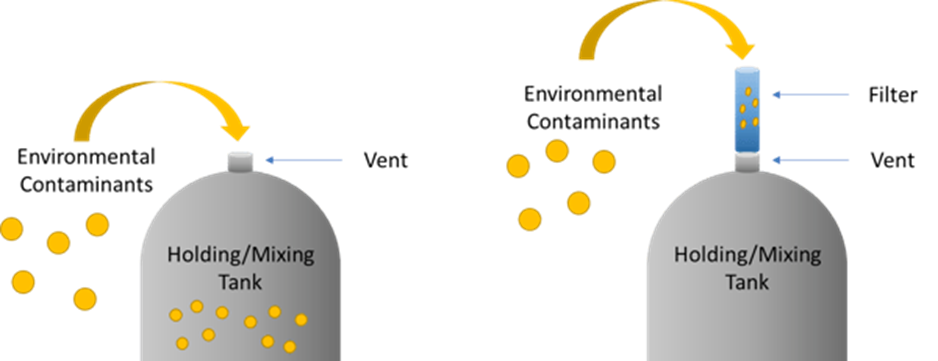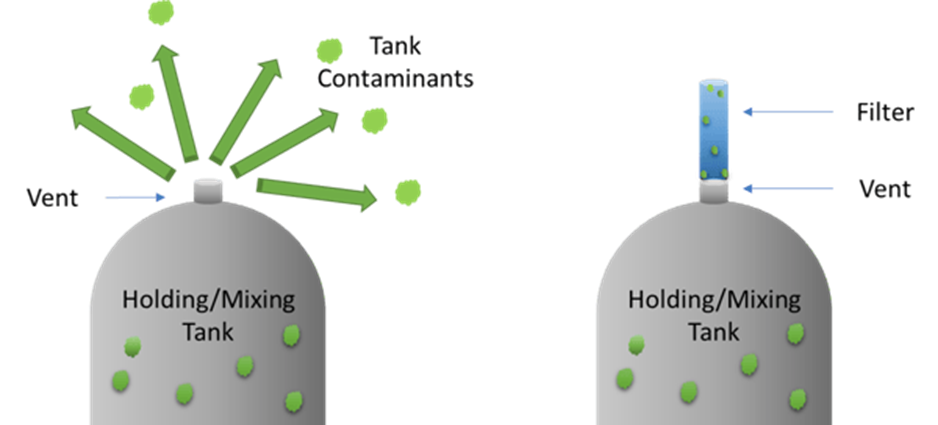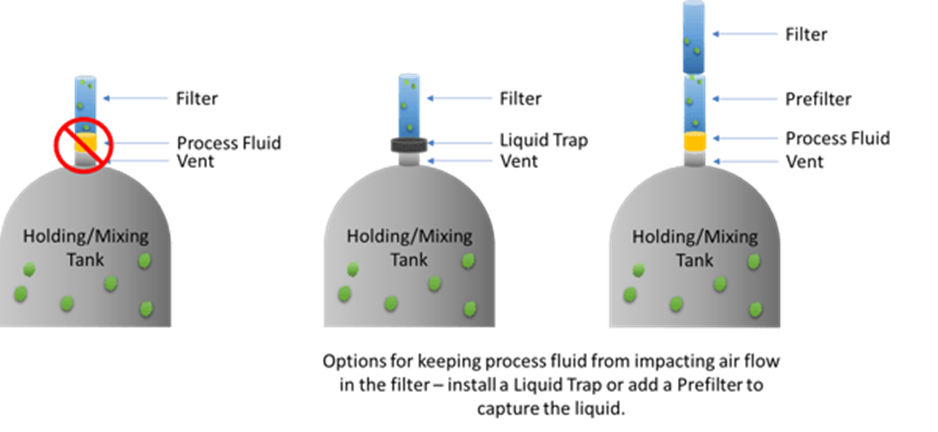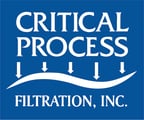Tanks must be vented to allow air to escape as the tank is filled and then to re-enter as the tank is drained. Structurally, improper venting could lead to catastrophic tank failures such as implosion or explosion.
The risks of not using vent filters on holding and mixing tanks are real and costly. Unfortunately, we usually hear from a company after they've experienced serious issues because they did not install vent filters. So, this article is written for those not yet using vent filters on their tanks. It will address the most common issues/questions we're asked on this topic with the hope of sparing you a process headache you don't need.
Many processes require the use of tanks for holding ingredients to be added into the process, mixing ingredients, or holding the final product pending final filtration and filling. During the course of normal operations, these tanks will be filled and emptied many times.
Tanks must be vented to allow air to escape as the tank is filled, and then to re-enter as the tank is drained. Structurally, improper venting could lead to catastrophic tank failures such as implosion or explosion. Before looking at why the vents on these tanks need to be filtered, let’s review the venting process.
Pressure buildup during filling.
As a tank is filled, process liquid displaces the air already in the tank. If the air has nowhere to go, the pressure inside the tank will increase as the liquid fills more of the tank, compressing the air into a smaller volume. If the process fluid is being pumped into the tank, this pressure could build high enough to cause the tank to rupture, spilling its contents (costly, valuable goods) and requiring expensive cleanup and repair.
Vacuum buildup during emptying.
As a full tank is being emptied, if air is not allowed in to displace the water it will start to create a vacuum within the tank. If the process is gravity fed from the tank, it will probably just stop flowing as the vacuum offsets the force of gravity. But if the tank contents are pulled out by a pump, this could create enough of a vacuum to cause tank implosion. Again, this will lead to a spill requiring expensive clean-up, loss of product, and tank repair or replacement.
I see why I need to vent my tank, but why a Vent Filter?
Two reasons.
First, a tank vent will allow air from the surrounding environment to enter as the tank is being emptied. There are contaminants in that air (dust, particles from other operations, bacteria, etc.) that can negatively affect the tank contents.
 Case Study: A company producing packaged water contacted us to help solve a problem with bacteria, yeast, and mold contamination in their final product. After discussing their process and when this issue began, it was noted that their water filtration process had been recently relocated - from an enclosed area with limited contact to a non-enclosed area open to the surrounding environment. Their water filtration process involved large holding tanks from which the final packages were filled. These tanks were vented but did not have any type of filtration in the vent piping. It was recommended to install a sterilizing vent filter on each tank and to consider installing a sterilizing 0.22-micron water filter at the inlet to their filling station. This solved their contamination problem.
Case Study: A company producing packaged water contacted us to help solve a problem with bacteria, yeast, and mold contamination in their final product. After discussing their process and when this issue began, it was noted that their water filtration process had been recently relocated - from an enclosed area with limited contact to a non-enclosed area open to the surrounding environment. Their water filtration process involved large holding tanks from which the final packages were filled. These tanks were vented but did not have any type of filtration in the vent piping. It was recommended to install a sterilizing vent filter on each tank and to consider installing a sterilizing 0.22-micron water filter at the inlet to their filling station. This solved their contamination problem.
Second, as the tank is filling, air will escape into the surrounding area. Vent filters serve to protect the local environment and workers from the material in the tank.
If your ingredients and products include toxic materials, gases or release fumes that cause illness, it is critical to use a vent filter. Industry regulations and manufacturing guidelines will dictate the necessity of environmental control. Your applications, tank location (clean room vs. factory floor), and processes will further define the need. In some cases, it may be necessary to do environmental testing to identify the particulates and contaminants in the area, which will then determine the correct vent filter. The nature (particulate or biological), size distribution, and concentration that may be present in the tank air space will help determine the appropriate filter.
 Case Study: A metal plating company was filtering a plating solution containing hazardous chemicals and heavy metals. They were concerned that fumes and droplets escaping from their holding tank could affect nearby equipment and pose a potential health hazard to employees in the surrounding area. They were considering enclosing the tank in a ventilated room but were looking for a simpler solution if one was available. It was recommended to try a 0.10-micron PTFE vent filter. This was shown to prevent vapor and droplets from escaping into the surrounding area, solving their potential problem without expensive building modifications.
Case Study: A metal plating company was filtering a plating solution containing hazardous chemicals and heavy metals. They were concerned that fumes and droplets escaping from their holding tank could affect nearby equipment and pose a potential health hazard to employees in the surrounding area. They were considering enclosing the tank in a ventilated room but were looking for a simpler solution if one was available. It was recommended to try a 0.10-micron PTFE vent filter. This was shown to prevent vapor and droplets from escaping into the surrounding area, solving their potential problem without expensive building modifications.
Contamination - how much do I need to remove?
Your application and products will determine the danger contaminants will cause and the amount and size of each that need to be removed. More critical applications (such as pharmaceutical or food and beverage processing) must take precautions not to contaminate their product. But even a more basic industrial process would benefit from basic tank vent filtration.
Perhaps you just need to keep dust and general debris out of your system. If you're an ink manufacturer, particles in the ink will cause jamming of printheads. And even though you filtered the ingredients before the final holding tank, the vent may have let in the particles that contaminated the batch. So, if you are just looking to keep general contaminants out, a nominally rated hydrophobic polypropylene or fiberglass depth filter may be sufficient.
Or perhaps you need to protect your process from bacterial contamination. The type and amount of microbial contamination you need to keep out of your tank will determine the degree of filtration required, i.e. the type of filter and pore size needed. If you are trying to protect your pharmaceutical water systems or food and beverage tank, typically an absolute-rated hydrophobic membrane filter of Polytetrafluoroethylene (PTFE) or Polyvinylidene Fluoride (PVDF) is the best choice. Whether to install a bioburden reduction or sterilizing grade would be determined by an appropriate risk assessment of your process.
What if my process fluid will wet out a typical hydrophobic vent filter?
It is important to prevent the vent filter from becoming wet with the process fluid. This would significantly impact the amount of air that can flow through the filter and may result in one of the unfortunate consequences described above. This requires care in the placement of the vent filter and may require a liquid trap between the tank and the filter. It might also require adding a depth filter between the tank and the vent filter to catch any droplets that may come off the tank.
 Case Study: A company was using PTFE vent filters on their fermentation tanks. They were experiencing intermittent bacteria contamination in the tanks. They didn’t think it was from the air as they had vent filters rated for aerosol sterilization installed. Further investigation showed that these filters were not rated for liquid sterilization. Their process allowed intermittent contact of the fermentation fluid with the vent filters, resulting in low-level bacteria passage into the liquid. It was recommended to install vent filters validated for liquid as well as aerosol bacteria retention. This eliminated their bacteria contamination issues.
Case Study: A company was using PTFE vent filters on their fermentation tanks. They were experiencing intermittent bacteria contamination in the tanks. They didn’t think it was from the air as they had vent filters rated for aerosol sterilization installed. Further investigation showed that these filters were not rated for liquid sterilization. Their process allowed intermittent contact of the fermentation fluid with the vent filters, resulting in low-level bacteria passage into the liquid. It was recommended to install vent filters validated for liquid as well as aerosol bacteria retention. This eliminated their bacteria contamination issues.
Does a Vent Filter impact the speed of filling or emptying my tank?
That will depend upon the size of the tank’s vent which can be sized to meet almost any flow rate. The desired flow rate and level of filtration required would be the two biggest inputs to determining the type and size vent filter required.
Is now a good time to evaluate your tank vent needs?
Now that we have examined why you need to vent your process tanks (to maintain the structural integrity of the tank) and the importance of installing vent filters (to protect tank contents and/or the surrounding environment) now is a good time to evaluate if you need a vent filter.
As we've discussed, several factors must be considered when choosing a vent filter.
- What are the type(s) and levels of contaminants in the surrounding environment?
- What level of filtration do I need to remove these contaminants?
- Is there anything in my process that may affect the surrounding environment?
- Process chemistry -- ideally the vent filter will not be wetted by the process liquid
- Process flow rate -- Air flow through the vent will equal the fluid flow rate filling/emptying the tank
Once these factors are determined, you can purchase and install the correct vent filters. This modest investment will help avoid costly mishaps and process upsets.
Critical Process Filtration can help evaluate your current process to select the appropriate vent filters or make recommendations to optimize the performance and cost of your vent filters. With over twenty-five years of experience as a mid-size manufacturer of process filters, you can count on experienced Applications and Process Support staff that will perform any testing required to identify the right vent filters for your process and will assist in validation as required. For more information on using vent filters to protect your process, contact us today at (603) 880-4420 or send us your questions here.
